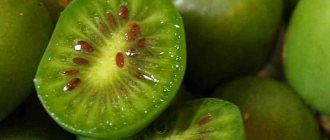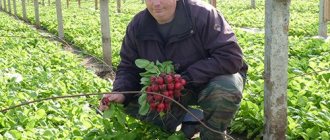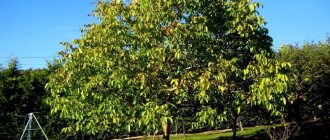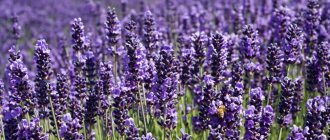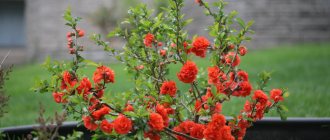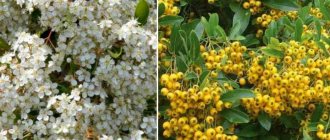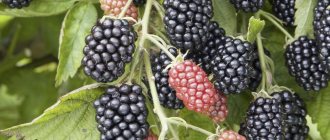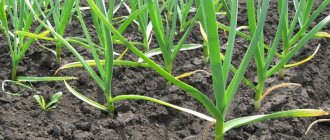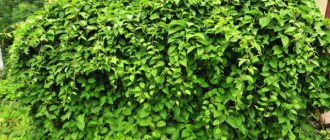Japanese quince care
Growing quince, planting and caring for it are not difficult. It is necessary to monitor weeds, prevent the occurrence of pests and diseases, prune bushes in a timely manner, insulate them for the winter so that the plant does not freeze, and water it.
Watering and fertilizing
After planting, the quince needs regular watering for the first time, especially if there is no rain. After moistening the soil, loosen the soil around the plant. You need to loosen to a depth of 10 cm, while simultaneously removing weeds. To keep the tree trunk moist, mulching is carried out. A layer (3-5 cm) of crushed bark, peat or sawdust is laid out over the entire crown projection.
For at least a year, the soil will not need additional fertilizing, because fertilizers were applied during planting. In the second year of life, the quince needs to be fed with organic and mineral fertilizers in the spring. The following is applied to one trunk circle: 100 g of potassium fertilizer, 300 g of superphosphate and a bucket of compost. In summer, you can use liquid fertilizing with mullein or ammonium nitrate solution.
Quince pruning
Japanese quince is a valuable plant for ornamental gardening. It tolerates fertilizer and pruning well. Sanitary pruning is carried out in the spring. Remove dry, improperly growing and damaged shoots. The cutting areas must be treated with garden varnish. Formative pruning of quince is also carried out in the spring. But it is necessary for plants that are more than 5 years old. It is necessary to ensure that the bush does not thicken and grow in breadth. Every year you need to cut out the root shoots, leaving 3 young offspring. Shoots that are located horizontally at a distance of 30 cm are the most valuable. Shoots that creep along the ground and grow vertically must be removed.
Upon reaching 8-10 years of age, shoot growth decreases to 10 cm. At this time, anti-aging pruning is necessary. The bush is first thinned out, leaving no more than 15 strong shoots. Fruits mainly appear on 3-4 year old branches, so you gradually need to replace them with young shoots, cutting out old branches.
Quince pest control
Diseases and pests rarely bother quince unless you take care of it at all. Natural disasters can provoke the occurrence of fungal infections. In rainy weather, necrosis or various spots often occur. The plant may be affected by ramularia or cytosporosis. Affected shoots are removed and burned. And the remaining shoots are treated with antifungal chemicals with copper.
The main pests of quince are spider mites and scale insects. It is easier to prevent their appearance than to try to get rid of them later. Preventive spraying is carried out before buds open, using the preparations Karbofos, Actellik, Aktara. Sometimes re-processing is not required.
https://youtube.com/watch?v=zF3MQT7x6hQ
Preparing for winter
Quinces are prepared for winter in late autumn. The tree trunk circle should be covered with spruce branches and a thick layer of dry foliage. Shortened cuttings or seedlings are covered with lutrasil or spunbond. Low growing shrubs can be covered with cardboard boxes or wooden crates.
How to grow Japanese quince in the garden, at the dacha
To plant chaenomelis, you need to choose a well-lit area. However, the shrub can exist in partial shade, but bears almost no fruit. The composition of the soil for quince does not matter, but it must be quite fertile. Only on open limestones and solonetzes does quince not grow. In cold regions, it is important to choose a place where snow easily accumulates, protecting the bushes from frost.
When and how to plant
Planting quince is possible both in spring and autumn, and seedlings with a closed root system can be planted in summer. Preference is given to spring planting, soon after the snow melts and the soil thaws. Two-year-old seedlings take root best. When planting several bushes, the distance between them is maintained at least a meter, in accordance with the characteristics of a particular variety (usually 3–5 bushes are planted in a line). Planting holes for spring planting are prepared in the fall. In Japanese quince, the roots go far deep, so when the diameter of the hole is about half a meter, its depth is made somewhat larger.
It is best to fill the planting hole with a mixture of leaf soil, sand and peat (2:1:2), adding 200 g of superphosphate, a couple of handfuls of wood ash and 1.5 buckets of humus to the mixture. If the soil is too acidic, add up to 300 g of chalk or lime. The planting technique is usual for shrubs, taking into account the fact that the root collar should eventually end up at soil level. If seedlings are purchased in containers, they are planted without being buried. There are usually no problems with the establishment of Japanese quince.
The most convenient way is seedlings in containers
Watering and fertilizing
It is necessary to regularly water the quince only in the first year after planting the seedling: subsequently, the roots themselves find water, watering is necessary only in case of severe drying out of the soil due to prolonged drought. In the first years, it is worth mulching the soil around young bushes with peat or sawdust, adding a layer of 3–4 cm. In the future, watering quinces can only be remembered in extremely hot summers.
The quince is fed twice a season: in the spring, nitrogen fertilizer is applied, or better yet, infusions of organic matter (mullein, bird droppings): this is done shortly before flowering. Soon after the end of flowering, during the formation of the ovaries, a complex fertilizer (for example, azofoska) is given.
Pruning: how to properly form a crown
Japanese quince bushes are very dense, therefore, in order to preserve their decorative appearance, they require sanitary and thinning pruning. In the spring, before the buds swell, remove old branches lying on the ground, as well as several old vertical shoots, so that their total number remains between 10 and 20. Dried, broken and frozen branches, as well as root shoots, are cut out. Every year, only 2–3 young vertical shoots are left from all those grown in the past season.
If you don't trim the bush at all, it very quickly becomes extremely thick.
Quince grows for a long time, but already at the age of 8–10 years you need to carefully examine the branches: if last season the growth was only about 10 cm, the bush requires rejuvenation. You will have to leave no more than a dozen of the strongest shoots, and remove the rest. All cuts of thick branches should be covered with garden varnish.
Fruit collection
The fruits of Japanese quince make excellent jams, jellies, and marmalades, so this shrub is grown not only for decorative purposes. And although its fruits, unlike its close relative, the common quince, are quite small, they try to collect and process them. As a rule, in the fall the bushes are literally strewn with small yellow fruits. A wax coating protects them from the mildest frosts, but you should try to collect them immediately before the temperature moves towards negative values.
Quince is stored at temperatures from 0° to +5°C, but it can be eaten fresh no earlier than the New Year: in the fall the fruits are very hard and tart. Actually, harvest processing does not begin immediately after harvesting, allowing the fruits to ripen during storage.
Transplanting an adult bush
Mature bushes endure replanting very painfully, since it is impossible to dig up a bush without seriously damaging the main root, which goes deep. Therefore, it is better to try not to move bushes from place to place. If an urgent need arises, you should try to dig up the bush with a large lump of earth, water it well after replanting and hope that everything will go fine.
Preparing for winter
It is important to try to cover the Japanese quince bush with snow for the winter and protect it from the piercing wind. Wooden shields help against winds, and covering the soil around the bush with coniferous spruce branches helps with snow retention. While the plant is young, they try to bend each shoot to the ground in the fall, after which they are sprinkled with fallen leaves, covered with straw or spruce branches. Sometimes even large cardboard boxes help. In the spring, it is important not to forget to remove the shelter in time and inspect the bush and trim the shoots.
In problem regions, non-woven materials are also used
Japanese chaenomeles species description
Japanese quince planting and care in open and closed ground
Japanese quince is a shrub, no more than 3 meters in height. Young shoots of the plant are scaly-felt, green, then they become black-brown and bare. The leaves are obovate, blade-shaped, narrowed towards the base, up to 5 cm long. When the plant is young, the leaves are almost bronze, then they become dark green. Flowers with a diameter of 5 cm form corymbose inflorescences of 2-6 pieces. They come in orange, bright red or pink. Small yellow-green round-shaped fruits, edible, ripen by mid-autumn.
The plant has been known since 1874. Despite the fact that the plant is very heat-loving, it can withstand severe frosts. Flower and annual shoots outside the snow level may freeze. In Siberia, quince cannot boast of such vigorous flowering as quince grown in the Moscow region.
What kind of plant is Chaenomeles?
Japanese quince is originally from Japan, but has long been cultivated in many countries in Asia and Europe.
Bush structure
A quince bush can reach a diameter of three meters, it has a dense crown with dense foliage, but most often the size of the bush is slightly more than a meter. Young shoots grow scaly, but then become bare, hairless, brown in color, covered with sparse spines. The leaves are most often obovate, several centimeters long and wide. In adult plants they are dark green.
The young bush grows slowly, but lives for several decades. The plant is thermophilic, but can also grow in cold regions, normally withstanding frosts down to -30 ºC under snow cover. This is a drought-resistant plant that requires almost no watering.
Flowering dates and when fruits ripen
Chaenomelis flowers are extremely beautiful. They are white, pink, orange or bright red in color, up to 5 cm in size, and there are from 2 to 6 copies in the shield. Flowering occurs at the end of spring and beginning of summer and lasts about three weeks. In mid-autumn, edible fruits ripen, and the first fruiting occurs already in the third year of the bush’s life. The fruits have an almost regular round shape, less often pear-shaped, yellow-green in color, size 3–6 cm, covered with a waxy coating. True, seeds can occupy up to the middle of the fruit’s volume. About 2 kg of fruits are collected from each bush, which can ripen in room conditions at low temperatures and be stored for a long time, until spring.
Japanese quince flowers are truly charming
Health benefits of lemon apples
Growing the crop is not difficult, and the fruits have considerable benefits. And although the taste of quince is not for everyone, it is not for nothing that it is called the northern lemon: for example, it contains even more ascorbic acid than real lemon, and it contains a variety of vitamins and biologically active substances. A variety of dishes are prepared from quince; it is almost never consumed fresh due to its astringent taste.
Japanese quince fruits are small, but there are a lot of them
Popular varieties of Chaenomeles
Among dozens of well-known varieties, the following are considered the most popular:
- Crimson & Gall (often used for making hedges);
- Pomegranate bracelet (low but productive shrub);
- Chaenomeles Simoni (very decorative, but not frost-resistant variety);
- Jet Trail (one of the few varieties that does not have thorns on the branches);
- Quince Vesuvius (bush with a very spreading crown);
- Chaenomeles Nivalis (a variety with white flowers, a rather voluminous bush).
Main varieties of Japanese quince
Krinum - garden flower, planting and care in open ground
Breeders have developed many varieties of Japanese quince. Let us give a brief description of only the most popular of them:
- Papel. Quince is decorative, with beautiful yellow flowers edged with a pink stripe.
- Malardi. It has pink flowers with white edges.
- Nikolai. A variety of Ukrainian selection, low and thornless, with a spreading crown. It blooms with orange-red flowers and has lumpy yellow fruits.
- Umbilicata. The variety, up to 2 meters high, was bred in Japan. This variety has relatively thorny branches. The plant blooms with pink-red flowers, spherical fruits up to 90 g.
- Pink Lady. A very bright, beautiful shrub with pink flowers. The shoots are prickly. The fruits are bright yellow and firm.
- Simoni. The variety comes from France. Reaches a height of 2 meters, has dense thorny branches, white flowers and yellow fruits.
- Likhtar. This variety is winter hardy. It blooms with bright orange flowers and has large round or ovoid fruits.
- Nivali. French variety with dense, thorny branches. The fruits are yellow, round.
- Crimson and Gold. A small shrub 1 meter high. Blooms with dark red flowers. The fruits of Japanese quince of this variety are ovoid, green-yellow, and have a thin skin.
- Gayardi. An ornamental plant that blooms with salmon-orange flowers.
- Merlozi. Variety from Belgium. It is distinguished by irregular pear-shaped green fruits.
- Fascination. Dutch variety with large red flowers and green fruits.
- Clementine. The plant blooms with bright red flowers in May, and fragrant fruits appear in late autumn.
You can also often find varieties such as Nika, Fragrant, Vitamin, Rubra, Krasnoplodny, Citrine, Ellie Mossel and others.
Varieties for growing in the Moscow region
The following varieties of Japanese quince are often grown in the Moscow region:
- Nivalis is a powerful plant, the height of which is up to 1.5 m. The flowers are white and the leaves are covered with a velvety coating;
- Simonii - shrubs covered with a large number of large leaves. The height of the plant is no more than 1.3 m. The flowers are dark red, which is typical for most varieties of Japanese quince. The fruits are large, yellow-green;
- Geisha Girl - bush height up to 1.5 m. It is covered with double flowers of a delicate cream color;
- Pink Lady is a slow-growing shrub, the height of which is no more than 1.4 m. The flowers are pink. This variety is able to tolerate severe frosts (down to -35°C) and grow in the shade. Therefore, it is ideal for cultivation in the central regions of the country;
- Fascination is a wide bush, up to 1.5 m high. The flowers are purple in color, collected in inflorescences.
What does it look like
Hyacinths planting and care in open ground, reproduction
The photo shows an adult fruit-bearing quince tree
Quince grows as a tree or shrub from 1.5 to 6 meters in height. The bark on the trunks is smooth. Young branches are fleecy. The leaves are dark green in color, grayish pubescent below, with a smooth edge and short petioles. The flowers on the branches are arranged in a single order, regular, five-petaled pale pink on low stalks. The fruits have the appearance of an apple or pear and are colored in different shades of yellow. Young ones are velvety, ripe ones are smooth to the touch. Their taste is tart, astringent, sweetish, the flesh is not juicy and hard due to the presence of a large number of stony cells. The oval-shaped seeds are brown. The tree blooms from May to June, and the fruits ripen in late autumn in September - October.
Description and features
Japanese quince, or chaenomeles of the Rosaceae family, is a spreading shrub, not exceeding 3 m in height. The plant forms spiny, arching shoots and small shiny foliage of dark green color. In May, the bush is decorated with ovoid or round flowers, the color of which varies from pink to orange-red.
The crop begins to bear fruit 3-4 years after planting. Japanese quince is famous for its fruits, which ripen in September and October. The fruits are medium in size, apple- or pear-shaped with many brown seeds. When eaten fresh, they have a sour taste, but when cooked, the flesh becomes pink in color, has a sweet pulp, and has a puree-like texture.
Advice! Japanese quince is considered a cross-pollinated plant, so for productivity it is necessary to plant 1-2 bushes of the crop nearby .
Ornamental chaenomeles is also popular among gardeners, like Chinese quince, because it can serve as a decoration for any garden plot, a source of vitamins and minerals contained in the medicinal fruits of the crop, while being unpretentious to cultivation conditions and does not require special care.
The best varieties for the Moscow region by ripening time
According to the timing of fruit ripening, cherry plum is divided into early, mid-early, middle, mid-late and late. The timing of fruit harvest depends on the variety and the further purpose of the crop. For fresh consumption and processing into juices, purees, and seasonings, the fruits are removed in the phase of full consumer ripeness, and for jams and compotes - at technical maturity. Prematurely harvested cherry plum fruits ripen poorly and do not achieve the characteristic taste qualities of the variety.
Early varieties of cherry plum for the Moscow region
There are very early ripening varieties of cherry plum, the harvest of which ripens in mid-July, that is, much earlier than domestic plums. The best selected forms were named taking into account their eastern origin: Chim-chuk, Cleopatra, Monomakh, Semiramis, Yarilo, Zlato Scythians, Naiad, Amazon, etc. A brief description of some varieties is given below.
Monomakh is an early ripening variety, productive and early fruiting. The fruits weigh 25 g, are shaped like Monomakh's cap, purple, sweet. The pulp is juicy, fibrous, the stone is easily separated.
Pramen is an early ripening variety, winter-hardy, high-yielding, early-fruiting. The tree is fast growing, with a spreading crown. The leaves are dark green and shiny. The fruits are medium-sized, weighing 18.5 g, round, yellow-green, with a large number of greenish dots on the skin. The pulp is yellow, tender, juicy. The stone is small and difficult to separate from the pulp.
Medium ripening varieties
Zlato Scythians is a medium-ripening variety, productive and early-fruiting. The fruits weigh up to 38 g, yellow, round, dessert taste, with a slight sourness near the skin. The pulp is juicy, fibrous, the stone is difficult to separate.
The Kolonnovidnaya variety has a compact crown, so dense planting is allowed for it (up to 0.5 m in a row), and it can be successfully used for decorative purposes. The fruits are large, tasty, dark red, medium ripening.
Late varieties of cherry plum
Cleopatra is a late-ripening variety, productive (14 kg of fruit from a six-year-old tree), early-fruiting. The fruits weigh up to 40 g, round, dark purple, almost black when fully ripe, with a strong waxy coating, sweet and sour. The pulp is dense, gristly, the stone is difficult to separate.
QUINCE IS AN EXOTIC SISTER OF APPLE AND PEAR TREES
Quince is a deciduous multi-stemmed shrub or tree with a height of 1.5 m to 3.5 m. It belongs to the Rosaceae family. Its closest relatives are the apple and pear trees.
There are three types of quince: Chinese, Japanese and common.
The first two belong to ornamental shrubs. And in this article we will talk about the fruit quince, which, in turn, is divided into pear-shaped, Portuguese and apple-shaped.
They differ from each other in the shape, size and taste of the fruit, which is 4 times higher in vitamins and nutrients than pear fruits.
The quince root system is superficial and highly branched. It consists of vertical and horizontal roots. The latter diverge in different directions and in mature trees reach a length of 8-10 m.
Quince is incredibly beautiful at the time of flowering, when its branches are literally covered with large snow-white or cream (depending on the variety) flowers, behind which you can’t even see the leaves. They emit such an amazing aroma that pollinating insects flock to my garden in clouds.
Large (up to 300 g), lumpy, golden or amber fruits are shaped like apples or pears. Their skin is dense and completely covered with thin soft fibers.
The pulp of the fruit is quite dense, slightly astringent in taste, but very aromatic. The most delicious is the pear-shaped quince. It is sweeter than other types and more juicy and soft, and its aroma is simply delicious. Most of the fruits of all types of quince are immediately processed. They are used to make preserves, jams, compotes, wine, dried and dried.
But the fruits of the latest varieties of pear-shaped quince can be eaten fresh. Children eat them with pleasure, grated without peel.
Quince is not in danger of bearing fruit periodically. It brings high yields every year. Sometimes the trees are literally covered with golden fruits, from a distance very similar to southern pears. From one tree you can harvest up to 70 kg of harvest.
As my practice has shown, modern varieties of frost-resistant quince are able to withstand winter frosts up to 39°, but in the presence of snow cover of at least 60 cm, therefore, in order to avoid freezing of the root system in snowless winters, the tree trunk circles should be insulated.
In general, quince is very unpretentious. It grows well in partial shade and in moist areas with close groundwater. It is not demanding on the composition of the soil. It can grow and bear fruit well on heavy clay, but provided that we improve its structure and create good water and air exchange. Grows best in nutrient-rich loam.
The advantages of quince include resistance to sudden temperature changes and recurrent spring frosts. During this period, its flower buds seem to “pupate” and do not die.
Northern varieties of quince are characterized by short stature (no higher than 2.7 m), which saves its wood from freezing.
Fruiting of the “northern” quince begins, as a rule, in the 4th year after planting, and the fruits are formed not only on annual branches, but also on the ringlets. Hence such high yields.
The lifespan of a tree is 60-70 years, but it can be extended with the help of anti-aging pruning.
Another advantage of northern varieties is resistance to all fungal diseases of pome crops!
Modern quince varieties are mostly partially self-fertile, but there are also non-self-fertile ones. In any case, if you want to grow this wonderful fruit crop, plant at least two plants of different varieties.
How to plant quince Planting quince care planting growing quince
Varieties
Teplovskaya
Bred in Astrakhan, it is productive and tolerates cold winters well. The fruits are apple-shaped, yellow in color, small in size with dense pulp, in which there are many stony inclusions located around the core. They keep well for 4 months.
Muscat
An unpretentious, medium-sized variety that easily adapts to different conditions. Resistant to frost and prolonged droughts. Grows on poor soils. He gets sick extremely rarely. The fruits are small (250 g) covered with fluff, reminiscent of felt. The pulp is light, somewhat harsh, with fibers, sweet with a pleasant sourness. The harvest is collected in September-October 45 kg per specimen.
Collective
Resists frost and drought, productive. Fruits in the form of apples of bright yellow color with light flesh with a small content of stony inclusions are collected from low trees. The fruits are stored for up to 3 months.
Rumo
The variety is popular among gardeners. The trees are of medium height, immune to diseases and severe frosts, with oval fruits (sometimes 500 g) and juicy, sweet and sour, non-astringent pulp. 70 kg of fruit are harvested from each tree. The harvest begins at the end of September.
Kuban harvest
The name speaks for itself. Fruits weighing up to 500 g are harvested from one tree with rough, juicy, cream-colored pulp that is aromatic and has a sweet and sour taste. The variety is resistant to heat, severe frosts, and pests. The harvest is harvested at the end of September and stored for a long time.
Golden
A small tree with thin intertwining branches and a spherical crown. The fruits are similar to an apple, slightly pubescent, weigh 200-400 g. Their flesh is hard and cream-colored. The harvest is harvested in the last ten days of September. One tree produces 40 kg of fruit.
Anzherskaya
French high-yielding variety. It resists fungal diseases well. The apple-shaped fruits have a smooth, lemon-colored skin with firm flesh and granules around the core that ripen quickly. They are consumed fresh and processed, stored for 60 days.
An excellent pupil
The variety was bred in the Nikitsky Botanical Garden. Trees of medium height with a luxurious crown. They love nutritious soils and give birth to up to 45 kg each. Heroically survives drought and severe frosts, but responds to abundant watering. Gives stable harvests for about 30 years. Ripens in the first ten days of October. Stores for 3 months.
Beretsky
This tall variety with a pyramidal crown was obtained in Hungary. Large thin-skinned fruits weighing 250 g are similar to a pear, ripen in October, but do not fall off the tree. They remain unchanged for 3 months. Fruiting occurs at the 3rd year of life.
Krasnoslobodskaya
The variety is productive, with average winter hardiness. The low-growing trees have a sparse spreading crown, the fruits are apple-shaped, ribbed with bright yellow, aromatic skin. The pulp is light, dense, juicy without stony formations. Shelf life 3 months.
Crimean early
Trees of medium height with a neat round crown begin to bear fruit within 3 years. The fruits are smooth, bright yellow in color with a sweet and sour tart taste. Ripeness occurs at the end of September. 40 kg of quince are harvested from one tree. The fruits do not respond well to long-distance transportation, so each specimen is packed in paper.
Ilmennaya
Winter hardiness is average, good yield. Round, large fruits with bright yellow skin. There are few stony particles in the sweet and sour pulp. Fruits are delicious both fresh and processed.
Harvest and storage
Japanese quince fruits are harvested in September – October, depending on the variety. It is important to harvest before frost sets in. Its quantity from one bush can be 1-2 kg, and with proper care up to 3 kg.
This fruit has good shelf life and, under proper storage conditions, does not lose its taste and commercial characteristics until spring.
Long-term preservation of fruits can be ensured due to the optimal temperature - from 0 to 1 degrees. It is also possible to store the crop at a higher temperature - up to 8 degrees, while the air humidity should be 80-90 percent.
In order for the Japanese quince harvest to retain its appearance and taste for as long as possible, you need to wrap each fruit in paper, lay it in layers in cardboard boxes, which are placed in a room with a cool temperature.
Chaenomeles, Japanese quince.
Chaenomeles (Chaenomeles japonica) is a perennial unpretentious plant and can grow on almost any soil, but develops better on light, sandy loam, wet loam or turfy podzolic soils. Waterlogged areas, as well as soils that have an alkaline reaction, are not suitable for growing this plant.
Chaenomeles are planted in light areas, and it is desirable that in winter a sufficient amount of snow accumulates there, which will protect the tips of the annual shoots from freezing. Before planting, the soil is first loosened, weeds are destroyed, and humus or peat compost (5 kg/m) is added. Prepare pits measuring 60x60x40 cm, which are filled with organic fertilizer (10 kg of humus), mineral fertilizers are added, and mixed with soil. To obtain a hedge, a distance of no more than half a meter is left between Chaenomeles bushes.
Chaenomeles is resistant to gas contamination and is well pruned. Caring for bushes consists of removing damaged, weak and dry branches. The height of the bush reaches up to one and a half meters. It has a long flowering period. Has a small number of needles. The fruits are yellow with a strong pleasant aroma and a lot of vitamins, which is why chaenomeles is also called Japanese quince. The fruit weight reaches 40 g. Chaenomeles fruits ripen in September. Its fruits are of universal use.
Chaenomeles fruits are used to make jams, jams, chips, or simply store slices sprinkled with sugar in the refrigerator.
To make jam, take one kilogram of chaenomeles, wash it, cut it into pieces, remove seeds, and cut into slices. Take four hundred grams of sugar and one glass of water, place in an enamel bowl and bring to a boil. Add quince slices to the resulting boiling syrup and cook for 5 minutes. Then leave to infuse for 12 hours. Then bring to a boil again and boil for 5 minutes. After another 12 hours, bring the jam to a boil, add one packet of vanillin, a handful of crushed walnuts and one lemon cut into thin slices along with the zest. The jam is brought to a boil and immediately rolled into prepared jars.
The most popular varieties of Chaenomeles include: Chaenomeles beautiful Texas Scarlet, Chaenomeles beautiful Jet Trail. These are low-growing shrubs with numerous white or red flowers. The fruits are suitable for consumption. When ripe they acquire a light yellow color. Planted on alpine hills, slopes, along areas in the form of hedges.
Return to page: Ornamental plants - 09
Home | Wild plants | Fruit and garden plants | Decorative plants | Houseplants | Descriptions of plants | Plant Properties | Berry and tree pests and diseases | Home Site Map
How to preserve your Chaenomeles harvest
- Chaenomeles fruits are generally small in size. They are hard and sour. But at the same time they have a delicious aroma and contain large quantities of vitamin C. However, eating them in this form is a dubious pleasure. Harvesting takes place in September - October, always before the arrival of frosty days.
- The fruits should be stored cool, the room temperature should not exceed 1-2 degrees. This regime must be maintained for three months. After the quince rests, it will become soft and sweet, and its aroma will become even stronger. In this state, this fruit is eaten.
- One of the ways to store quince fruits is as follows. Fruits need to be cut into small pieces and grated or chopped in a blender. Then sugar is added in a one to one ratio. The resulting mass is stored in the refrigerator.
- Drinks are prepared from this preparation and added to tea. They also make jam, jam, and compote from chaenomeles. It should be taken into account that when cut, fruits quickly acquire a dark shade, since they contain iron.
Japanese quince (Chaenomeles) performs in the garden the functions of both a fruit shrub and an ornamental one: during flowering this plant is extremely beautiful. And although it is not very widespread in our country yet, its popularity is clearly growing. After all, growing quince is not at all difficult, and the edible fruits have a wide variety of uses.
There are three types of quince
- Common quince is a tree with large fruits with golden, aromatic skin.
- Japanese quince and Chinese quince are low shrubs with small fruits.
Common quince is widespread in the Caucasus, Ukraine and the southern regions of Russia. But common quince varieties have been developed that grow successfully in Belarus, the Moscow region and central Russia, for example Moskovskaya Susova.
This is an unpretentious plant to grow, the fruits of which are rich in pectin, which removes radiation and heavy metals from the body, and also contain a large amount of vitamins and antioxidants, which have an antitumor effect, restore immunity, and reduce cholesterol levels. Already the ancient Greeks and Romans were aware of the medicinal properties of this plant. By the way, there is a version that it was because of the common quince fruit that the Trojan War began, and not because of the apple.
Other methods of reproduction
Among other methods of propagation of chaenomeles, there are such as dividing the bush and horizontal layering.
Dividing the bush
Reproduction by dividing the bush is the easiest method for Japanese quince. To carry it out, the root shoots of the mother bush are taken - young plants grown from buds located on the surface roots. Shoots that have well-developed roots are separated from the root shoots and transplanted into the ground.
Horizontal layering
Chaenomeles often grows shoots that spread along the ground. If you bury them, seedlings will grow from them. They are used for further reproduction. You can also tilt those shoots that grow horizontally close to the ground. Then they are buried in the same way as creeping ones - to obtain seedlings.
Reproduction of Japanese quince
There are several ways to propagate quince: cuttings, grafting, seeds and root suckers.
Propagation by cuttings
Propagation by cuttings has an undoubted advantage: preserving the varietal properties of the plant. In hot, dry weather at the beginning of summer, you need to cut green cuttings. On each of them, on the lower cut there should be a heel up to 1 cm long (this is a piece of last year’s wood). Also, the cuttings should have 1-2 buds.
Propagation by seeds
Reproduction from seeds can be considered the most reliable. Fresh Chaenomeles seeds have 80% germination rate. They are sown in the soil before winter, and vigorous shoots can be obtained in the spring. Long taproots will be formed by biennial seedlings. They need to be planted in a permanent place as quickly as possible.
If time is lost or you were unable to sow the seeds in the fall, you need to put them in the refrigerator in a bag of wet sand. There they will remain for 2-3 months. Seeds can be sown in the ground as soon as they hatch.
Reproduction by root suckers
The root shoots of Chaenomeles are quite large. The bush grows very wide. A 20-year-old plant requires an area of about 2 square meters. Root suckers, about 5 mm thick and about 15 cm long, can be dug up and planted. Young shoots are regularly watered, and the soil surface is mulched with wood chips, shavings or humus. The disadvantage of propagating Japanese quince by root suckers is that the root system of the suckers is not developed, it has to be grown.
Reproduction by grafting
In May, quince can be grafted using the improved copulation method. The varietal cutting acts as a scion. The rootstock will be a seedling of rosaceous crops or the main species. At the end of summer, during the period of active sap flow, you can vaccinate with an eye. To do this, use a sharp knife to cut off a bud with a piece of bark from the middle part of the varietal shoot. A T-shaped cut is made on the shield (bark of the rootstock), the edges are folded back, and a shield with an eye is inserted. The bent edges are pressed against the shield, the scion is tightly tied at the grafting site so that the eye itself is not covered with a bandage. In a month, if everything was done correctly, the eye should take root. The bandage is removed when the new bud sprouts next year.
Propagation by cuttings
The process of propagation by cuttings is called grafting. It is carried out at the beginning of summer as follows:
- First you need to cut cuttings that are one year old, along with the so-called heel. The heel is a piece of wood left over from last year.
- In order for the cuttings to take root better, they need to be treated with Kornevin. This plant stimulating preparation contains an acid, which, by irritating the tissues of the integument, promotes the appearance of callus. Callus is the name given to growths formed from living cells closest to the wound.
- Next, the cuttings are planted at an angle into a shkolka - a mini-bed in which plants with different growth periods are grown.
- In order to maintain the required level of humidity, the planted cuttings are covered with polyethylene.
- In the fall, the resulting seedlings are assigned to a permanent place. Sometimes this is done in the spring.
On a note! You can take cuttings in the fall. In this case, they are buried under the bush at a depth of about 25 cm. In this case, you must not forget to mark the place. In winter, callus forms at the tips of the petioles, and in the spring they are planted stationary .
Diseases
Quidonia suffers greatly from a fungal infection, which leads to the death of the ovaries. It survives the winter on infested trees and dried fruit. At the beginning of the disease, the leaves become covered with brown spots. Gradually growing, they close the boundaries and occupy the entire surface. During the flowering period, fungal spores penetrate the stigmas, where they take root and take root in the young ovary, destroying it. To a lesser extent, the plant suffers from fruit rot and brownish leaves.
Struggle
In order for the tree to be healthy and produce a harvest, it is necessary to promptly pay attention to lesions and take the following preventive measures:
- Collect and destroy dry parts on the tree: fruits, branches, to prevent the death of the ovaries, the appearance of leaf-mining moths, and the appearance of brown spots.
- Before flowering, the tree is treated with a 0.15% solution of dipterex and 0.1% foundationol (against leaf-laminating moths and ovary rotting).
- At the time of flowering, 0.8% benomyl is used to prevent the death of embryos.
- At the end of this period it is combined with 0.12% dipterex. This helps to cope with rotting of the future crop, browning of leaves and other troubles.
- If oidium is found on the tree, then the treatment described in the previous paragraph is repeated after two weeks.
Many different dishes are prepared from bodryana. Let's list just a few of them.
How to deal with diseases and pests
The main enemy of Japanese quince is aphids. It can become a real disaster for Chaenomeles. At the slightest sign of aphids, the plant must be treated with a special compound.
With high air humidity in damp and cold weather, excellent conditions arise for the occurrence of various fungal diseases:
- With necrosis and the appearance of various spots on the foliage, the plant becomes deformed and dries out;
- With cercospora, various brown spots appear, which then become pale;
- With ramularia, brown spots are visible on the foliage.
Effective control methods are the use of a copper-soap solution and 0.2% foundation.
The least dangerous is spraying plants with a tincture made from onions. To prepare it, you need to pour 150 g of husk into 10 liters of water and let it brew for a day. The resulting composition is used to treat the bushes every 5 days.
Care
Trimming
Using this procedure, a tree crown is formed, consisting of 8-10 main branches located evenly and receiving a sufficient amount of light. Usually there are from 8 to 10 of them. In 3-4 years, a full-fledged plant is obtained.
- Formation begins on one-year-old seedlings. Measure a trunk 60 cm high from the ground, count 7-8 buds up and trim. The first tier consists of 4-5 branches located every 10-15 cm. Then they begin to form the second layer, spaced 30-40 cm from each other at an angle of at least 45 degrees relative to the trunk.
- For a two-year-old tree, first shorten the lower skeletal branches of the first tier to 50-60 cm. The rest of the pruning is done in the same way.
- In the third year, the crown is already formed. Young developed trees are pruned lightly during this period. Only branches growing into the middle of the crown, rubbing, intertwining, interfering, or shading each other are removed.
Quince fruits are formed at the ends of strong annual branches, and in the lower part the flower buds are dormant. As a result, these areas become bare, so mature shoots are cut off by 1/4 - 1/3 of their length every year.
Rapid fruiting slows down the development of the tree. You can give an impetus to the resumption of growth by shortening the skeletal branches to old wood; in addition, living pruning of quince is carried out annually, which gives a good increase.
The mature tree develops inactively, and tops appear. In such cases, it is pruned according to its condition. Fortunately, quince has a high regenerative potential, so in the spring many buds that have been dormant for the time being can wake up. Due to them, the crown will be completely rejuvenated.
And lastly, quince is pruned, like other plants, in the spring, before the sap begins to flow. At the end of the procedure, the wounds are cleaned with a sharp knife and covered with garden varnish.
Top dressing
For the full development of quinces, fertilizers are applied. In autumn, large doses are given to accumulate a supply of nutrients in the soil. At the beginning of summer, nitrogen fertilizers are preferred, in the second half - potassium-phosphorus fertilizers.
Care during growth
Quinces need to be loosened frequently, but not deeper than 10 cm. Otherwise, the root system can be damaged. In the first year of life, it is important to remove weeds from the near-trunk part of the seedling, otherwise they will suck all the microelements from the soil.
Young and one-year-old seedlings should be covered with spruce branches for the winter for better wintering.
It is also worth pruning the plant. Remove excess and old, diseased knots. In the spring, remove all frozen and damaged branches, shorten last year's shoots by a third or half. The middle of the crown should not be too thick, so it is also thinned out.
Quince - varieties and varieties.
Depending on their origin and the growing conditions used, quince varieties differ in the level of winter hardiness, yield, technological properties, size, taste, immunity to pests and diseases.
The most winter-hardy quince varieties of custom origin are Akhtubinskaya, Volgogradskaya, Maslyonka early, Maslyonka late, Teplovskaya.
The following varieties stand out for their good technological qualities of large or medium-sized fruits, but low winter hardiness: Ispolinskaya, Champion (American), Beretsky, Portuguese (European), Dessertnaya, Izobilnaya. Suitable for consumption in raw, fresh form: Arevik, Volzhskaya, Nordon, Early Maslyonka, Akhtubinskaya, In Ukraine, quince is zoned in the Crimea (varieties Beretsky, Izobilnaya, Konstantinopolskaya, Otlitnitsa, Portuguese). Chernivtsi region (Beretsky, Sorotsky, Turunchutsky). Transcarpathian region (Beretsky).
Local forms of quince of ordinary selection were obtained in the process of growing several generations of seedlings from Crimean quince seeds and selecting the most winter-hardy and productive ones. The common quince here is located on the northern border of its fruiting, and the selected forms are valuable because they are the basis for the spread of cultural forms to the south.
As a result of studying more than 50 forms, the most promising ones for winter hardiness, fruit quality, and yield were developed. The best of these forms: 1-2, 2-12, 4-8-7, 17-5, 19-5, seedling Alyonka, as well as the forms of Academician Kashchenko. M.F 8:18.
Based on the ripening period, the forms are divided into 3 groups: 1 - early, with a ripening period from September 15 to 30, 2 - medium, from October 1 to 17, 2 - late, from October 15 to 30. Fruit ripening in early forms begins after 114 - 127 days, in middle forms - after 130 - 137, in late forms - 141 - 153 days after flowering.
Selected forms of quince bear fruit every year, the yield of 15-year-old plantings is 27.5-34.5 kg, 45-year-old plantings are 50.1-90.5 per tree. The average weight of fruits in early forms varies and is 150-260 g, in some forms (seedling Alena, 17-5), 250-310 g, 410-620 g. All bred forms have apple-like fruits.
Quince - Form No. 8.
Bred by M. F. Kashchenko from seedlings obtained from the seeds of Crimean quince varieties. A mother tree with 15 stem branches with a diameter of 12 to 34 cm, a height of up to 4 meters, a crown diameter of 15 m. The ripening period for quince fruits “form 8” is September 8-25. One of the early forms.
The average weight of the fruit is 230-250 g, height 55-65 mm, width 65-75 mm. The peel of the fruit is a beautiful lemon-yellow color, ripe fruits are almost without pubescence, the flesh is juicy, tender, sweet and sour, aromatic. The fruits contain 17.05-18.03% of dry matter, 6.5-8.3 of sugar, 03.2-04.3 of tannins, 10.55-39.24 mg% of vitamin C. Acidity - 03.5-1.12%. The yield per tree is 75-110 kg.
Quince - Form No. 19-15.
Bred from free-pollinated seedlings of local reproduction. A low tree with skeletal branches that grow upward. The leader is well expressed. The standard is up to 75-85 cm in height, with gray-black bark that cracks and falls off. The average fruit weight is 240-265 g, width 75-88 mm, height 72-76 mm. The fruits sometimes vary in size, with an average ripening date of September 25th.
Apple-shaped fruits, almost smooth, are very beautiful. The peel of the fruit is thin, tender, matte yellow, smooth with a slight blush. The pulp is juicy, yellowish, slightly tart in taste. It gets dark quickly in the air. The seed chamber is small in size. The fruits contain 16.4-8.75 - sugar, 0.22-0.25% - tannins, 16.5-20.22 mg% - vitamin C, acidity - 0.34-1.21%. Quince variety.
Pests and diseases
Quince suffers from the same diseases as pear and apple trees. And their pests are the same.
Diseases:
- fruit rot,
- septoria,
- scab,
- brownishness of leaves,
- molinosis,
- rust,
- powdery mildew,
- cystosporosis,
- anthracnose,
- phyllostictosis,
- tomato ringspot virus.
Pests:
- codling moth,
- leafmining moth,
- round-mining moth,
- apple blossom beetle,
- aphid,
- apple false bark beetle,
- fruit mites.
Features of planting and propagation of quince
For better plant survival, it is better to plant one or two-year-old seedlings or saplings. This guarantees the preservation of the varietal qualities of the original plant. The optimal time is from April to May for central Russia and autumn for the southern regions.
Determine in advance a suitable place on the site, well-warmed by the sun, closed to drafts. Cydonia is not very demanding on soil, but prefers slightly acidic or neutral soil (pH in the range of 5–6.5). This substrate is typical for many garden plots. Be sure to clear the proposed planting site of weeds, especially creeping wheatgrass, which also prefers slightly acidic soils.
Planting quince in the ground is a simple procedure
It must be borne in mind that if for some reason you want to transplant an adult plant to another place, this will be problematic. Japanese quince has a well-developed root system with a long central root and the procedure is very painful for it.
The planting itself and preparation for it looks like this:
- A hole of 40x40x40 cm is dug or, if you plan to make a hedge or border, a trench of appropriate length. The fertile layer of soil is deposited separately. If groundwater is close, then the soil is deepened another 20 cm and drainage is poured onto the bottom: expanded clay, crushed stone, broken brick, coarse sand. The pit is prepared 2–3 weeks before the intended planting.
- The extracted fertile soil (upper 15–20 cm), a bucket of humus or dry manure, 0.5 kg of wood ash and 150 g of double superphosphate are mixed. Everything is thoroughly mixed.
- The mixture is poured into the hole and compacted.
- Damaged roots of seedlings are cut off.
- A recess is made in the center of the prepared hole in accordance with the size of the root system. The planting depth depends on the type of seedling. If it is seeded or vegetatively propagated, it is necessary to maintain the same level of immersion in the soil. When a scion is planted, the seedling must be buried 15–20 cm so that it takes root on its own.
- The hole is carefully filled with earth, which must be compacted well to eliminate voids at the roots. Next comes watering and mulching.
- The seedling is trimmed to a height of 15–20 cm.
Reproduction
Quidonia propagates quite easily: by seeds, cuttings, vegetative layering, dividing the bush, through grafting onto a rootstock. Some features of each method:
- Propagation by seeds. Planting material is taken only from fully ripened fruits. Stratification is definitely needed. Seeds are planted directly in the ground before winter, or you can first keep them in damp sand at a temperature of 0–3ºС for at least 2–3 months. Cold-stratified seeds are planted in the soil in early spring. Germination may be low, so it is better to prepare more of them. Quidonia fruits contain a lot of seeds, so there should be no problems with planting material. With such propagation, the generic characteristics of the mother plant are not preserved.
- Propagation by cuttings. Planting material - tops of annual shoots with 2-3 internodes. The sections are treated with Kornevin or another biostimulant and placed in a mixture of peat and sand (1:2). In this case, the cuttings are tilted approximately 45º. It is advisable to place the containers in a small greenhouse and regularly spray the substrate to create increased humidity.
- Reproduction by vegetative layering. The easiest way. In the spring, a 1–2-year-old side stem is dug in. By autumn, as a rule, root shoots appear. Next, the stem is cut off from the parent bush and planted in a new place, as described above.
- Dividing the bush. There is one significant drawback: the dug up part slowly takes root in a new place.
- Grafting a cutting. The fastest way to propagate Chaenomeles. It consists of grafting a cutting with 2-3 buds onto a rootstock, which can be pear, rowan, serviceberry and hawthorn. Hybrids quickly begin to grow; often the first flowering is observed already in the year of grafting.
For those who like to experiment with plant grafting in their garden, we will add that there is experience in using Japanese quince as a rootstock for pears. The hybrid turns out to be more winter-hardy, early-fruiting, and compact. The fusion of the scion with the rootstock is good.
Propagation by seeds
Important! When propagated by seeds, Chaenomeles loses some of the qualities inherent in this variety. Therefore, this method is used for growing rootstocks for subsequent regrafting. .
You need to know the following about propagation by seeds:
- After the quince produces seeds in the fall, they must be placed in damp sand throughout the winter. In this case, the ambient temperature should approach zero. Under such conditions, seeds undergo stratification.
- You need to sow seeds in February - March in special planting boxes.
- After a month and a half, the seeds are distributed into separate containers.
- By the end of May - beginning of June, planting in open ground takes place.
- During the summer, the sprouts are watered and fertilized.
- In winter, it is necessary to insulate the seedlings with dry leaves.
- The germination rate of Chaenomeles seeds is good. Therefore, seedlings require thinning. In this case, you need to remove the weakest ones of all.
There is another way of planting - without wintering in wet sand. Seeds can be immediately planted in the beds, covered with soil, covered with polyethylene and a layer of fallen leaves.
Note! Stratification is a process that imitates natural winter conditions in order to increase seed germination. For Japanese quince, it is indicated if the seeds are planted in the spring. When planting in autumn, natural stratification occurs .
Quince tree planting and care
How to grow quince
The plant can be grown from seeds, but this method will take a lot of time. It is better to purchase a ready-made seedling of a variety that will overwinter in your climatic conditions. Quince is unpretentious in choosing soil, but it will grow best on light, fertile soils. Proximity to a water source - a river, lake or just a stream - has a good effect on quince.
Planting rules for quince are similar to conventional planting of fruit trees. See more: Pear: planting and care in the first years
Common quince can be planted in autumn or spring, while the tree is dormant. Choose a sunny, quiet place for planting. Since this tree grows very unevenly, in the first year of its life it is necessary to tie it to supports so that the trunk becomes stronger. At the age of five years, the plant will not need special care and will bear fruit.
By the way: quince can be grafted into the crown of a pear. And then you will not only get the harvest faster, but the pear will also bear fruit much more abundantly, because the flowering quince attracts pollinating insects with its aroma.
How to prune a quince
This is not only a fruit-bearing plant, but also very decorative, as it forms a beautiful cup-shaped crown. In order to form properly, the tree needs pruning in the first four years.
Pruning is carried out in the spring. The main branches are cut off by half the annual growth and the side branches that thicken the central part of the crown are cut off. All root shoots at the base must be removed and unnecessary shoots on the trunk must be cut out. Once the plant reaches five years of age, pruning is no longer required.
Important! Common quince bears fruit on last year's growth. Therefore, after five years, the trees are not shortened, since such pruning destroys the fruit buds, and therefore the harvest.
You can only cut out branches that thicken the center of the crown and basal shoots.
What other care does quince require?
In the spring, the tree needs to be fed with complex fertilizer, and in early summer with ammonium sulfate and humus.
And in areas with a cool climate, it will be useful to carry out treatment against moniliosis in the spring. To do this, spray the plant with any copper-containing preparation at the beginning of flowering.
When the first fruits appear on the tree, you should not pick them right away. Over time they will ripen and become tastier. And even the collected fruits must be kept for about a month before being eaten.
(Visited 1 times, 8 visits today)
Proper pruning
Formative pruning of Chaenomeles begins in the fourth season, since only at this age the shoots of the bushes begin to branch. Cut out shoots that grow inside the bush, excess growth growing from the roots, leaving no more than 3 young stems annually. Stems that grow along the ground also need to be pruned.
Remove all weak and thin branches, leaving no more than 10 shoots . During the pruning process, fairly young branches (which are 4 years old) should be left; older shoots should be removed.
Japanese quince is a beautiful ornamental shrub that also produces tasty and healthy fruits. With proper care, it can grow in one place for up to 35–40 years, delighting with its flowering and good harvests.
Features of growing Japanese quince
Growing Japanese quince, planting and caring for it are determined by the rules for growing garden shrubs.
When and where to plant quince
It is better to plant in the spring before sap flow begins. Autumn planting is less desirable, otherwise the heat-loving plant will not have time to take root before the onset of frost. Two-year-old seedlings with a closed root system are used as planting material. They need to be watered thoroughly before planting. If seedlings with bare roots are used, they need to be inspected; you can soak them in water for several hours, then remove damaged and rotten roots.
It is necessary to plant chaenomeles in light areas, although it tolerates partial shade well, it can develop, but does not bloom so luxuriantly. The plant prefers soil rich in humus; it is better if it is light - loamy, soddy-podzolic, sandy loam, slightly acidic. Japanese quince does not tolerate peat soils well. For planting, you need to choose a place protected from drafts and winds. It is better on the southwest or south side of the house. When choosing a site, you must remember that the quince will grow in this place for about 60 years; it does not like transplanting.
How to land
It is necessary to follow some rules when planting. The soil for planting should begin to be prepared in the fall. It is cleared of weeds, then carefully dug up with the addition of sand and leaf soil. When digging, peat manure compost is added (10 kg added per square meter). Also add 40 g of fertilizers with phosphorus and potassium.
To plant a tree, you need to pour a mound of soil mixture into the center of the hole, install a seedling in it, straightening the roots. The root collar should be on the surface. The space around the seedling is filled with fertile soil. After planting, water the tree abundantly and compact the surface. The shoots are shortened by 17 cm.
Planting quince in open ground
To grow a beautiful and fruit-bearing plant, you will need to plant it correctly. First of all, choose a high-quality seat so that the quince feels comfortable. You should also choose a healthy seedling. It is best to do this in specialized nurseries to purchase planting material that is resistant to frost, diseases and pests. The surface of the seedlings should be free of any stains, plaque or cracks. Their presence can lead to the plant not taking root well.
Did you know? During Tudor rule, quince were made into marmalade, which was considered a powerful aphrodisiac.
Landing dates
It is necessary to plant Japanese quince in the spring, when the soil warms up to +10°C. The ambient temperature should be from +15°C to +17°C. The plant takes root best if planted in the morning or evening, when there is no active sunlight. This can lead to burns on the crown. If you plant Japanese quince in the fall, this may negatively affect its development. Young plants will not have time to take root before the onset of frost and will freeze.
Selecting a location
Japanese quince should be planted in sunny areas. In the shade, shrubs grow poorly and the flowering process is disrupted. Try to plant the crop in places that are protected from northern winds and drafts. Japanese quince prefers to grow in loamy soils with low acidity. The optimal pH balance is no more than 6.
Soil preparation
Since the crop prefers to grow on nutritious and fertile soils, it is necessary to prepare the planting site in advance. First, the area must be thoroughly watered so that the soil is moistened to a depth of 40 cm. After this, apply organic fertilizers (rotted manure or peat) in the amount of 20 kg per 1 m².
After 2-3 days, when water and nutrients penetrate the inner layers of the earth, you can begin marking the garden. Dig holes measuring 60x60 cm. The distance between bushes should be 1.5 m. If you are going to grow Japanese quince as a hedge, then maintain a distance between bushes of 80 cm.
You need to add 10 kg of humus and 500 g of wood ash to the dug hole. After this, add about 5 kg of garden soil and mix all the ingredients thoroughly. When all the steps have been completed, begin the planting procedure.
The harmfulness of quince
Quince, as a medicinal plant, has a number of contraindications:
- the seeds have an astringent effect, which is why infusions from them are not used by people with ulcers and enterocolitis;
- do not use in the presence of constipation, pleurisy;
- The peel can irritate the larynx, so singers should use quince with caution.
Important! Quince seeds are strictly prohibited from being crushed or consumed in crushed form. During processing, a substance unsafe for humans is released - amygdalin.
Troubles that can befall a tree
The main reason that many summer residents refuse to plant amazing plants on their site is the instability of quince to diseases. In addition, quince is a favorite delicacy among rodents, birds and pests of pome crops.
To avoid many troubles associated with diseases and pests, quince should be planted at some distance from apple trees, hawthorn and rowan.
The most common disease of the crop is fruit rot - moliniasis of pome fruit. The disease can only be eliminated with an integrated approach. To fight the disease you need:
- trim and burn affected branches;
- disinfect wounds with mercuric chloride.
Eliminating a disease is much more difficult than preventing it. For preventive purposes, it is recommended to spray the tree with foundationazole and dipterex during the period from the swelling of the buds to the appearance of the first flowers. Treatment with these products is carried out in accordance with the manufacturer's recommendations. Subcutaneous fruit spot can also cause great harm to unripe fruits. The disease reduces the high quality of quince and makes the fruit unattractive. To prevent the disease, the plant should be fed with boric acid or zinc sulfate. Also, when choosing a variety for cultivation, preference should be given to the one that is most resistant to the disease. Quince is also affected by brown leaf spot, which is caused by certain fungi. During the flowering period of the plant, fungal spores fall on the flowers and subsequently lead to the fall of the ovaries. Prevention of the disease is simple: timely spraying with foundationazole. The most popular insects that love to eat quince include:
- apple false bark beetle. It can only be eliminated mechanically: insects are collected by hand in April and September, when inspecting tree trunks and branches;
- codling moth. To preserve the harvest, fruits that have reached a diameter of more than 2.5 cm are placed in paper bags for further growth and full ripening;
- leaf moths. These insects are immune to insecticides. They fight the pest mechanically by cutting off infected leaves. Iridescent beetles, the natural enemies of moths, are excellent helpers in fighting them.
SELECTION OF QUINCE SEEDLINGS.
A few words about planting material. It should be purchased only from large, trusted companies that are responsible for the quality of their products and can provide you with a certificate of quality and compliance with the variety being sold.
Do not buy frost-resistant quince seedlings at markets or along roads! They simply aren't there! At best, they will slip you a decorative Japanese quince, at worst - some variety brought from the south, because today there is a demand for northern quince. In the first winter such a tree will die!
It is better to buy an annual seedling 30-40 cm high, which will take root faster. He must be vaccinated. This is indicated by an annular thickening near the root collar.
A one-year-old seedling must have at least 5 pairs of leaves. The stem is usually straight, without thickenings or growths, and light brown in color. The root system should consist of 4-6 strong roots.
It is better to plant northern quince in the spring, so that the young plants take root well and take root over the summer.


